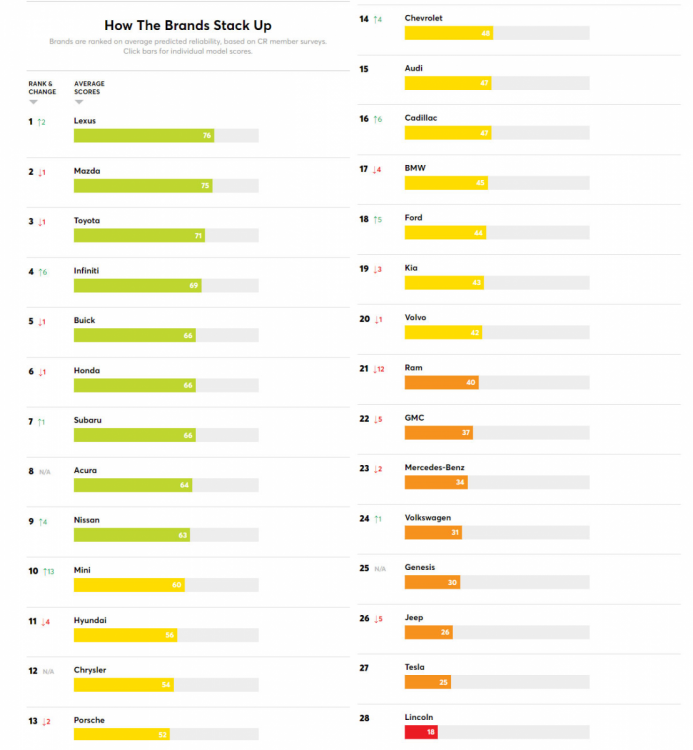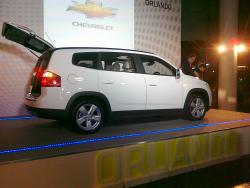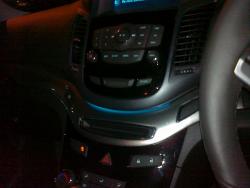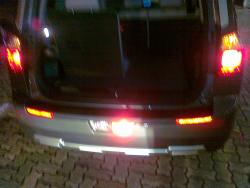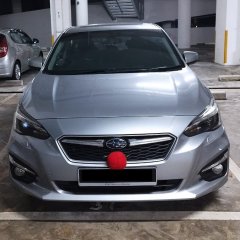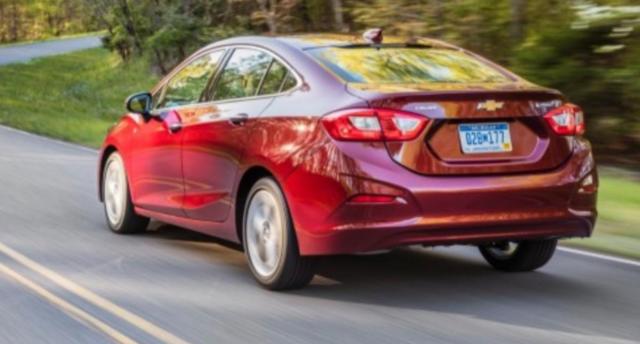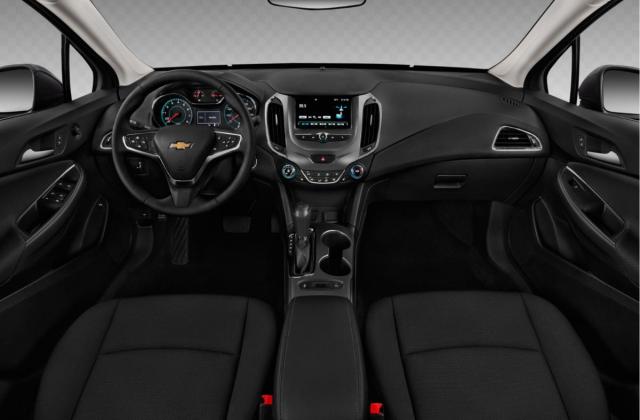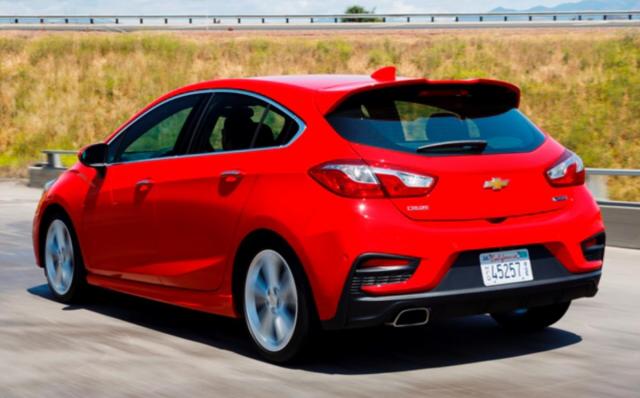Search the Community
Showing results for 'chevrolet' in topics.
-
Consumer Reports’ New Annual Auto Reliability Data Reveals Safest Bets and Riskiest Choices Among New Vehicles Lexus achieves top spot among automakers in auto reliability brand ranking with Mazda, Toyota, close behind. Buick continues as the most reliable domestic brand--and the only one in top 10. https://www.consumerreports.org/media-room/press-releases/2021/11/consumer-reports-new-annual-auto-reliability-data-reveals-safest-bets-and-riskiest-choices-among-new-vehicles/ Release date 11/18/2021. YONKERS, NY — Eight of the top ten most reliable brands are from Asia, and only one--Buick--is a domestic, according to the latest Annual Auto Reliability data from Consumer Reports (CR), the nonprofit research, testing, and consumer advocacy organization. But there were some positive indicators for the domestics, too, as American models topped seven vehicle categories--an unusually strong showing. The 2021 Auto Reliability Report is based on data collected from CR members about their experiences with more than 300,000 vehicles in the annual surveys. The survey findings were announced at an online news conference before the Detroit-based Automotive Press Association today. Owners reported everything from transmissions needing replacement after as little as 5,000 miles to display screens that required hardware replacement and misaligned tailgates and doors. "With new-car prices at all-time highs and a shortage of vehicles on dealers’ lots, it’s more important than ever to consider reliability when you invest in something new,” said Jake Fisher, senior director of auto testing at Consumer Reports. “Buying a reliable vehicle can help ensure that you’ll be able to hit the road when you need to, and not worry about getting stuck waiting on parts for repairs.” Other highlights from CR’s influential annual report include the following: Despite their complexity, hybrids and plug-in vehicles are among the most reliable models. High-end electric-powered Sport Utility Vehicles are among the least reliable vehicles, but NOT because of their relatively simple powertrains. Complex electronics are their Achilles Heel, at least for now. Some Hyundai, Kia, Subaru, and Toyota models continue to have problems due to technologically advanced, and complex, transmissions. CR’s auto statisticians calculate reliability ratings for every major mainstream car, minivan, SUV, and truck on the market, even ones that are brand-new and redesigned for 2021. To do so, the team analyzes annual CR member surveys data on a model’s reliability history, calculating the brand’s overall reliability and, if applicable, the reliability of models that use some of the same components. Consumer Reports’ analysis of new-car reliability is a key element of CR’s Overall Score, which is a holistic measure of a vehicle’s quality designed to make it easy for consumers to quickly find the best cars, SUVs, and trucks to suit their needs. The Overall Score also includes road-test performance, owner satisfaction survey results, whether a vehicle comes with key active safety systems, and results from crash tests, if applicable. “The pandemic is creating a scramble for consumers as they face a reduced supply of new cars and significantly higher prices. That's why it's more important than ever that people get trusted help finding safe, secure, and reliable vehicles,” said Marta Tellado, President and CEO of Consumer Reports. “Our annual reliability reports, combined with our comprehensive auto testing, can empower consumers with the trusted information to make better purchases and navigate this unusually difficult marketplace.” Eight of the 10 Top Brands are from Asia Of the top ten most reliable automakers, eight are headquartered in Asia, with Lexus, Mazda, and Toyota in the top three spots respectively. Historically, Lexus and Toyota have regularly been at the top of CR’s brand rankings for reliability. That’s an especially noteworthy accomplishment for Toyota, which has a wide array of different nameplates in the survey--13 in all. Mazda, which was the top brand overall last year, falls to second place. Mazda’s above average overall performance was marred by the Mazda3 small car, which has average predicted reliability due to problems with its climate system and in-car electronics issues. Mazda has a conservative design approach with shared platforms and similar components, which helps it to produce reliable vehicles overall. Mazda has also stuck with its dependable six-speed automatic transmission while other automakers use more complex ones with eight or nine ratios or continuously variable transmissions, some of which have proven troublesome. All Lexus models score average or better for reliability in CR’s report. The Lexus GX SUV is the most reliable new vehicle overall this year; owners reported no problems for the three model years that CR analyzed in the brand rankings. The UX is Lexus' only average model. Third-ranking Toyota has only one model scoring below average, the Corolla Hatchback; CR’s members reported issues that required a transmission replacement or rebuild. The RAV4 remains average mostly because of problems filling the fuel tank on some versions. The Tacoma and the redesigned-for-2021 Sienna are both also average; the Sienna showed some power equipment problems. Both the RAV4 Prime and Venza, new for 2021, are well above average. Infiniti ranks fourth overall, an admirable improvement of six spots this year. The Q50 sedan remains impressive and the troublesome QX50 SUV improved to average. Buick is the most reliable domestic brand, coming in at fifth place overall. The Encore and redesigned Envision are both well-above average, and the Encore GX is above average. Surprisingly, the Enclave drops to below average, with transmission, drive system, and blank in-car electronics screen issues. High Rankings for Several Domestic Models Mark Signs of Improvement for U.S. Manufacturers Models from five domestic brands, Buick, Chevrolet, GMC, Chrysler, and Ford, take the top spots in seven categories--an unusually strong showing. They include: Buick Envision (Luxury Compact SUVs) Chevrolet Trailblazer (Subcompact SUVs) Chevrolet Silverado 2500HD and its twin the GMC Sierra 2500HD (Full-sized Pickups) Chrysler 300 (Midsized/Large Cars) Ford Bronco Sport (Compact SUVs) Ford Mustang Mach-E (Electric SUVs) Ford Ranger (Midsized Pickups) CR’s data also shows that hybrids and plug-in vehicles are among the most reliable models even though they have unusually complicated drivetrains. These vehicles include the Honda Insight, Kia Niro and the Toyota Prius, Prius Prime, RAV4 Prime, and Venza. One likely reason for their reliability is that most of these are well-established models that haven’t seen radical changes over the years. Even the new-for-2021 Venza uses a tried-and-true powertrain. The analysis also shows that fully-electric SUVs are among the least reliable vehicles. They include the Tesla Model X and Y, Audi E-Tron and Volkswagen ID.4. All have a high rate of problems in areas other than the electric powertrain. Some of these problems include climate controls, in-car electronics, and power equipment. Honda Ranks Sixth in Brand Rankings Honda ranks sixth among brands, down one from last year, with the Insight scoring well-above average. The CR-V, Accord, and Ridgeline score above average and the remaining models are all average. Both the Passport and Odyssey have improved, though owners still report issues with the infotainment system freezing and power equipment. Some Odyssey owners also report problems with the sliding doors. Subaru comes in seventh overall. The Crosstrek is well-above average, and the Legacy, Impreza, and Forester are above average. However, the Ascent still has subpar reliability. Acura's rank is eighth overall. The TLX has exhibited impressive reliability in its first year after a redesign, and the redesigned 2022 MDX has above average first-year reliability after below-average reliability with its previous generation. The RDX improves from below average to average, though it still has ongoing issues with brakes, power equipment, and in-car electronics with the display screen freezing and needing hardware replacement, and software updates failing. Nissan improves this year, moving up to ninth place--mostly because of older models including the Rogue Sport, Murano, and Leaf, which show impressive reliability. Mini rounds out the top 10, making it the highest-ranked European automaker this year. Mini only has two models in the survey, the Cooper Countryman and Cooper/Clubman, and jumps 13 places in the standing. The jump is mainly attributed to its Cooper Countryman's outstanding reliability. Hyundai falls four positions this year to rank eleventh. The redesigned Tucson is well-above average, and the Sonata and Palisade are also above average. The Kona Electric and freshened Santa Fe are below average, with, respectively, battery pack and electric drive motor problems, and transmission and power equipment issues. Kia drops three to 19th place this year, with transmissions being the brand's weak spot. The eight-speed dual clutch transmission that is used with the turbo engine in the redesigned Sorento is problematic. Owners of the Soul, Seltos, and Forte report a problem-prone CVT that could require replacement. The Niro Electric improved and the Telluride remains outstanding. Genesis’ reliability is suffering as the brand rapidly grows with new models. While the G70 has improved to average, the new GV80 SUV scores well-below average due to infotainment screen and drive system problems. Four Domestic Brands are Midpack Domestic brands are midpack or below--Chrysler at 12th, Chevrolet at 14, Cadillac at 16th, and Ford at 18th. Jeep, Tesla, and Lincoln took the three bottom ranks. Chrysler has just two vehicles in the survey--the 300, which has outstanding reliability, and the Pacifica minivan, which is well-below average due to issues including the transmission and sliding doors. Chevrolet models spread across almost the entire range of CR’s reliability scale--some excellent and some subpar. The new Trailblazer SUV and the Trax are both excellent. After years of respectable reliability, the Bolt EV dropped to below average, due to battery problems and electric drive failures, among other issues. The Silverado 2500HD and Blazer are above average. Others, including the Corvette and redesigned Tahoe, are well-below average. GMC's rank dropped because of similar problems as twin models from Chevrolet. The Sierra 1500, Yukon, and Canyon are all below- or well-below average. GMC’s only above-average vehicle was the Sierra 2500HD. Cadillac improved six spots this year, helped by the reliable XT5 SUV. The XT6 and XT4 are below- and well-below average, respectively. Ford is showing improvement this year, with the new Bronco Sport, Mustang Mach-E, and Ranger all at the top of their classes for reliability. But the redesigned F-150 scored below average, as did the Escape. Both the Mustang and the Explorer are well-below average. Ram drops the most in CR’s brand ranking this year, sliding twelve spots to 21st. While the Ram 2500 and 1500 are both average, the 1500 Classic (the previous generation 1500) has well-below average reliability marked by problems with brakes, emissions systems, engine, and power equipment. Jeep ranks 26 and among the bottom three brands. The company’s most reliable model last year, the Gladiator, fell below average. The Cherokee and Wrangler are both below average. The Wrangler has issues with the drive system, in-car electronics, and, like the similar Gladiator, with the steering and suspension. The Cherokee has in-car electronics and some transmission issues. Tesla, with four models in the survey, is unchanged at second from last. While Tesla’s Model 3 has average reliability, the Model Y still has body hardware issues with the tailgate and door alignment, paint defects, and multiple other problems. The Model X and Model S both have body hardware, climate system, and in-car electronics problems. All Lincoln models have below-average reliability, with the Corsair and Aviator being well-below average. They, along with the Nautilus, have transmission, in-car electronics and power equipment problems. Mixed Bag for European Models Porsche ranks midpack at 13, down two from last year. The Cayenne and Macan have average and above-average reliability. Audi is unchanged at 15th. The A4 and A5 remain above average, and are joined by the A6 and Q5. The Q7 is average, but the Q3 has below-average reliability. The Q8 and E-Tron, both well-below average, continue to have drive system and power equipment issues. BMW is in 17th, down four. The X5, 3 Series, 5 Series, and X3 all have average reliability, but the redesigned 4 Series has subpar reliability due to power equipment problems. Volvo is 20th overall, down one. The XC90 continues to score well-below average, mostly due to issues with brakes, climate system, and body hardware. The S60 dropped to below average this year also because of multiple issues. The XC40 is average and the XC60 is now above average. Mercedes-Benz is in 23rd, down two from last year. The only reliable model is the GLC. The E-Class fell to below average and the GLE remains well-below average, with numerous power equipment, climate system, in-car electronics, and some engine problems. Volkswagen is at 24th overall, up 1 from last year. While the Atlas and Jetta improved to average reliability, the Tiguan and the new ID.4 EV are both subpar. For more information on CR’s 2021 #CRCarReliability findings, visit CR.org/reliability or follow us on Facebook, Twitter and Instagram @consumereports. About Consumer Reports Annual Auto Reliability Surveys The latest Consumer Reports Annual Auto Reliability Surveys, gathered information from the organization's members on more than 300,000 vehicles from model years 2000 to 2021. Members filled out online surveys in the spring and summer of 2021. CR’s reliability predictions are based on overall reliability for the past three model years, provided the vehicle has not been redesigned. One or two years of data will be used if the model was redesigned in 2021 or 2020. CR bases its reliability analysis on data gathered from CR members each year about problems they had with their vehicles in the past 12 months. CR’s team of statisticians and survey researchers, then analyzed trouble areas and created an overall reliability score for each model and year. Serious problem areas that can lead to expensive repairs are more heavily weighted. More information can be found at www.CR.org.
- 28 replies
-
- 3
-

-
- consumer reports
- car reliability
-
(and 1 more)
Tagged with:
-

30 Discontinued Cars That Won't Make It To 2024
kobayashiGT posted a topic in General Car Discussion
We're nearing the end of 2023, which means the door is closing on a number of vehicles as automakers have rolled out most of their new products for next year. That means many of the cars, trucks, and SUVs that we love so much won't make it to 2024. Luxury brands like Audi and Mercedes-Benz are putting multiple cars to rest as they prep new products, while American automakers like Chrysler and Dodge have at least one vehicle going the way of the dodo as they prep for the upcoming EV onslaught. Even a few supercars won’t stick around next year, some destined to be replaced by more powerful models. More cars will join this list next year. For now, let's say our goodbyes and remember those vehicles we've lost. Alpina BMW B7 Alpina inked a deal with BMW early last year that ended the in-house tuner's independent run, giving the automaker full control of the company after 2025. With that, the Alpina B7 – based on the BMW 7 Series – won't see a direct successor based on the current generation with other Alpina models in danger of being discontinued as well. Audi R8 Audi's enduring supercar is finally reaching the end of the line. With the 2023 GT RWD model announced for the US (and priced at a cool $251,395), production of the R8 is officially winding down after 16 years spanning two generations. Audi TT The Audi TT will say its goodbyes after 25 years. The iconic sports car survived two and a half decades before the automaker made the decision to move on from the nameplate. Buyers in the UK will see a Final Edition model for 2023, while the RS Heritage Edition introduced last year will be the last of its kind for the US. Chevrolet Bolt EV The bigger Bolt EUV arrived with Chevy's refresh in 2022 boasting more interior passenger space, and for the first time, Super Cruise on a Chevy product. It too, though, was discontinued. It's unclear whether the new Ultium-based Bolt expected in the next few years will also include the larger EUV. Chevrolet Camaro Turbo The Chevrolet Camaro nameplate as a whole will stick around for one more year before it too is discontinued – but the base turbo model won’t. Chevrolet confirmed that the four-cylinder Camaro won’t be available for the 2024 model year, which means the base motor is now the 3.6-liter V6 making 335 hp. That version starts at $32,495. Chrysler 300 Chrysler is rolling out just a few thousand examples of the 300 sedan for the 2023 model year; only 2,300 units are available for buyers this year in both V8 and V6 variants. This 300, though, marks the end of the line for the muscle car after this generation survived 18 years following its debut for the 2005 model year. Dodge Challenger Dodge is reluctantly discontinuing the Challenger as the automaker moves to electrification, specifically with the arrival of the new Charger Daytona SRT EV. As one final act, though, Dodge released a variety of "Last Call" special edition Challengers, including the limited Demon 170 with 1,025 horsepower and a ridiculous 0-60 time of just 1.7 seconds. Dodge Charger Like the Challenger, Dodge is discontinuing the Charger sedan. The Charger sedan has been a staple in the Dodge lineup since its debut in 2006, with some truly awesome models like the Scat Pack, the Hellcat, and the Hellcat Redeye in that successful 17-year production run. Dodge Hellcat Models But it's not just the Challenger and Charger names that will be discontinued after the 2023 model year – Dodge is killing the entire Hellcat line, too. Reports indicate that the final Hellcat engine will be built later this year with the iconic supercharged 6.2-liter V8 engine being phased out. Ferrari F8 Tributo Ferrari’s 488 replacement had a relatively short run. Believe it or not, only one (1) example of the F8 Tributo was officially imported into the US. But don’t worry, buyers that want the F8 coupe’s same stellar performance with the upgrade of a removable roof can still get their hands on an F8 Spider. That version starts at $319,342 and packs the same 3.9-liter V8 engine with 710 hp. Ferrari Portofino M Say arrivederci to the lovely Ferrari Portofino M as it’s set to be replaced by the Roma Spider in 2024. The Roma Spider boasts a more-powerful twin-turbocharged 3.9-liter V8 engine that gives it 612 horsepower and 561 pound-feet of torque, and it offers a traditional cloth roof as opposed to the Portofino’s convertible hardtop, which helps with weight. Ford Edge The mid-size Ford Edge probably won't survive after this year in part due to labor disputes at the automaker's Oakville Assembly plant in Canada. That, and the Blue Oval's ongoing transition to EVs. The Edge will live on in China in the form of a longer-wheelbase hybrid crossover, but there are currently no plans to bring that SUV to America. And as for the Lincoln Nautilus – the Edge's more luxurious cousin – it recently underwent a major makeover for the 2024 model year. Ford Explorer Hybrid If you work in law enforcement, you can still buy a Ford Explorer Hybrid. But for the average man, Ford is killing off its fuel-sipping mid-sizer. The current iteration of the Explorer Hybrid debuted in 2020, but it won't make to the 2024 model year. Hopefully another hybrid SUV is on the way. Ford Fiesta Although Ford hasn’t sold the Fiesta in the US since 2019, the seventh-generation model was available in Europe – but now it's being discontinued, too. Ford plans to fill its spot in the lineup with an all-electric version of the Puma crossover, with the last few examples of the Fiesta expected to roll out of Ford’s German factory in June. Ford Transit Connect Ford's smallest work van, the Transit Connect, won't survive through the 2024 model year. The company did have a new version of the Transit planned using the Maverick's platform, but those plans have reportedly been scrapped as well. Kia Stinger Although it was rumored that the Kia Stinger would be discontinued before the 2023 model year, the sporty sedan is at least sticking around for another short run before production ends in 2024. As a sendoff to the Stinger, Kia introduced a Tribute Edition model with Moonscape matte paint and new 19-inch wheels, with only 1,000 units planned worldwide. Kia Rio Kia is killing off the Rio for the 2024 model year. The automaker's smallest vehicle has been around globally since 1999, and this current generation debuted for the US in 2016. As of this year, it's still one of the cheapest cars in America with a base starting price of $17,875. There's still a change it will be replaced by a new affordable offering next year. Lincoln Aviator Grand Touring Like the Explorer, Lincoln is also discontinuing its mid-size SUV hybrid option. The Aviator Grand Touring won't make it to 2024, which, unlike the Ford, was a plug-in-hybrid vehicle and qualified for the full $7,500 tax credit in the US. Next year the Aviator will only be available with a twin-turbocharged 3.0-liter V6. Mazda CX-9 Mazda is discontinuing one three-row SUV in place of another. The longstanding CX-9 will disappear after the 2023 model year in place of the new-and-much-improved CX-90. The new CX-90 has more space, a punchier turbocharged inline-six engine, and for the first time on any Mazda of this size, a plug-in-hybrid option with up to 26 miles of range. The CX-9 won’t be missed. Mazda MX-30 Another Mazda that won’t survive in the US into 2024 is the compact MX-30 EV. With an abysmal 100 miles of range and a $34,645 starting price, the MX-30 was relatively fun to drive, but it didn’t offer enough range for its asking price. And you could only buy it in California. Hopefully better EVs are on the way from Mazda. McLaren 720S McLaren has already shut the door on the 720S sports car with production quietly coming to an end late last year. But the supercar maker already has a successor on the way dubbed the 750S – and it’s sold out until late next year. The 750S will reportedly have up to 740 hp and could debut as early as this month. Mercedes-Benz C-Class Cabriolet Mercedes is trimming down its lineup pretty dramatically. Last year the company discontinued the A-Class and CLS, and now the C-Class Cabriolet is next in line. The timeline isn’t totally clear, but reports suggest the C-Class convertible will be discontinued sometime between 2023 and 2024, meaning it likely won’t survive through the 2024 model year. Mercedes-Benz C-Class Coupe The C-Class convertible won’t be the only discontinued version of the compact luxury car. Mercedes also plans to kill off the C-Class Coupe at the same time, leaving only the sedan in the lineup for the foreseeable future. Mercedes-Benz CLS Another victim of Mercedes-Benz’s ongoing lineup simplification is the CLS. Last year the company killed off its sporty CLS 53 offering, but now the entire nameplate will disappear as production is officially slated to end in August. Mercedes-Benz E-Class Cabriolet The E-Class Cabriolet will follow the C-Class convertible on its way out the door with the larger two-door also being discontinued. It will follow the same timeline as the C-Class, with production slated to end sometime between this year and next. Mercedes-Benz E-Class Coupe And of course, just like the C-Class, Mercedes-Benz is also killing the E-Class Coupe sometime between now and 2024. With those two two-doors being discontinued, that means the updated AMG GT – whenever it debuts – will be the only true coupe in the lineup, not counting the many four-door "coupes." Mercedes-Benz Metris It might not be Mercedes-Benz’s most well-known model, but the Metris has been a staple among work vans since 1996. Now it’s being discontinued. Both the work and passenger versions of the Metris will be disappearing after this year. Nissan Maxima Nissan's full-size Maxima will reach the end of the line before the end of 2023. It was rumored that Nissan would replace the Maxima will a full-size EV last year, but with no new electric sedan on the way anytime soon, Nissan has quietly killed the Maxima prior to the 2024 model year. Porsche Panamera Sport Turismo With the debut of the new Panamera, Porsche is discontinuing the wagon variant in the US due to slow sales. The Sport Turismo accounted for less than 10 percent of total demand for the previous Panamera. -
Hertz going backwards on EV cars. Who wants to buy ? Car rental firm Hertz to sell 20,000 EVs for gas-powered vehicles :Hertz Global Holdings will sell about 20,000 electric vehicles (EVs) from its U.S. fleet, the rental firm said on Thursday, citing higher expenses related to collision and damage, and opt for gas-powered vehicles. Shares of the company, which operates EVs made by Tesla Inc and Swedish EV maker Polestar, fell as much as 9 per cent in premarket trading. "Expenses related to collision and damage, primarily associated with EVs, remained high in the quarter, thereby supporting the company's decision to initiate the material reduction in the EV fleet," Hertz said. Hertz expects to recognize about $245 million of incremental depreciation expenses from the proposed sale in the fourth quarter of 2023. Hertz said in April 2022 that it would buy up to 65,000 EVs over five years from Polestar, months after the rental car firm decided to order 100,000 Tesla vehicles by the end of 2022. The company's used car website has a variety of more than 700 EVs on sale, from BMW's i3 and Chevrolet's Bolt to Tesla's Model 3 and Model Y SUVs.
-
How come they are not bringing this here? It looks so sexy.
-
Source: https://www.motor1.com/news/686396/2024-hyundai-konda-electric-debut/ Hyundai today released additional details about the 2024 Kona Electric, including preliminary range estimates, specifications, and US availability. The current generation is among the few affordable electric vehicles in the US starting at under $35,000. The next generation is imminent and seems like a significant upgrade, at least on paper. The Korean carmaker had shared powertrain and production details early this year, but now we a few more details on the US-spec model. Design The Kona Electric’s nose is more aerodynamic with cleaner surfacing, and it continues to feature a split headlamp design, although the LED DRL is now full-width. Designers have also attempted to embed the parametric design theme from the Ioniq 5 with the creases on the side profile, and sculpted wheel arches, although reminiscence to its bigger sibling is little to none. It’s also more slippery, with a drag coefficient of 0.27, a slight improvement over the previous figure of 0.29. It also features active grill shutters to improve airflow when closed and cool the battery when open. The EV is longer, wider, and has an enlarged wheelbase compared to its predecessor. It measures 171.5 inches long (+5.9 inches), 71.9 inches wide (+1 inch), and 62.2 inches tall. Boot space is rated at 25.5 cubic feet, while the frunk only offers nine-tenths of a cubic foot (27 liters) of space. Battery, Range The Chevrolet Bolt EV competitor features a marginally larger battery pack, but the range estimates are nearly identical. The current Kona Electric draws power from a 64-kilowatt-hour pack, while the 2024 model will feature a 64.8 kWh battery capacity. Hyundai’s preliminary internal testing has indicated a 260-mile range, just two miles more than the current generation's 258-mile EPA range. The standard battery variant is estimated to have 197 miles of range. Charging times have improved slightly. Ten to 80 percent state of charge (SoC) can be achieved in 43 minutes with 400V Level 3 DC fast charging. Customers living in the colder US regions can also opt for battery pre-conditioning. Power output remains identical, with the long-range version’s front axle-mounted electric motor delivering 201 horsepower and 188 pound-foot of torque, while the standard range variant is rated for 133 hp and 188 lb-ft. More Features New features include vehicle-to-load functionality, with 1.7 kilowatts of maximum power output. There's also a new Smart Regenerative system which can alter the brake energy regeneration strength based on real-time traffic, an improved interior with ambient lighting, body-colored interior accents, and dual 12.3-inch panoramic screens for the gauge cluster and infotainment among other items.
-
An American beauty. More Picture & source here. http://www.autoblog.com/2007/12/21/ed-pepe...ctors-bring-it/ GM thinks that the Corvette ZR1 is pretty much the baddest machine on four wheels, period. This was driven home today in a post on the Fastlane Blog by Chevy general manager Ed Peper. Seeing him advocate his brand's (and GM's) flagship is far from surprising, and as he rattles off the car's positives, it seems like pretty standard-issue public relations fare. It's only as he wraps up that he seems to get a little exercised over some folks' habit of turning all Corvette-related conversations into pushroad vs. overhead-cam arguments. In response, he namechecks some very heavy hitters -- the Porsche 911 GT2, the Ferrari 599 GTB, and the Lambo LP640 -- as he casually pulls the gloves off, matter-of-factly stating that the ZR1 has a better power-to-weight ratio than all of them. Then, in his parting shot, he dons the brass knuckles and calls out any and all comers who would challenge the Corvette ZR1's abilities with two simple words: "Bring it." You know what it is when this kind of smack talk starts flying around? It's fun. And we haven't even heard from Lutz yet. ----------------------------------------------
-
Just back from a road trip to USA. Thought good to share what I have learnt along the way as there is definitely a learning process for those not used to driving LHD cars in winter climate. This is not going to be exhaustive handbook but just some pointers to help in the itinerary planning process. Winter tires necessary for winter climate going up Canada? This had been one of my biggest worry as I have read that winter tires are compulsory for cars in Canada. I am concern as I will be travelling to Niagara falls at Canada side. Online research did not provide me with a definite answer, other than that it is compulsory for cars from some time ago. Taking to a few Canadian angmos also did not yield any definite answers, but their cars are definitely with winter tires. So that added to my worries as what if my rental car collected from Washington DC got turned back at immigration checkpoint. I felt relieved only when the staff at Thrifty assured me that their fleet comes with all weather tires which would be good for going up Canada, that the winter tire ruling is only for cars purchased in Canada but not on rental cars. So indeed it went smoothly through the Canada leg without any issues. Road travel during winter Another concern is whether winter tires or even tires chain necessary during winter. The answer is not necessary. What is confusing is that different states have different policies with regards to this, but mostly is about permitting and not about being mandatory. But most car rental companies would not allow tires chains as could damage the tires. When there is snowing, can see specially equipped pickups or trucks with shovel busy plying the roads to push the snow away. You will also observe many black "gravels" on the road during winter, which have been dispensed from these vehicles which are salt used to de-ice the road. They could be brown or black depending on states. Be careful when driving over bridges as bridges will freeze before tar road to create slippery surfaces when temperature dips. It would be good planning to start driving only after 9am when the sun is already up to reduce chances of accidents due to car sliding on roads as seen on news, another good excuse to wake up later. On days when snowing overnight, be sure to cater at least 15min to warm up the car and turn on windscreen heating coil to thaw the front and rear windscreens. Rental cars should come with low grade ice scraper with a brush end and a plastic pointed end. Use the pointer end to scape the ice then use the brush end to remove the ice. Very easy to do. Also remember to be de-icing wiper fluid from Walmart or petrol stations to topup the fluid tank. Normal water will freeze at tubing outside the hood thus not able to clear up the windscreen when needed. My rental car will squirt some water when toggle to do windscreen wiping, and with normal water even if can come out will freeze at windscreen causing it to be more blurry. But with de-icing fluid, the wiper is able to clean up very nicely. Also try not to drive after sky darken from about 4+pm till 6pm depending on states. USA span across 6 timing zones for those not initiated. Due to poor time management, I have to drive a few nights till 8pm to reach my destination. Very bad decision thinking back. Roads in USA is not like over here with street lights all over. Even across those inter-state expressways, there are no street lights at all so is almost pitch dark. So driving at night has a tunnel effects which worsen because you can only see slightly ahead and there are many winding roads. The drivers there also do not have a habit of turning on high beams during my time there. Frankly with cars going at excess of 65 mph, it is really quite harrowing to do cornering without any lights. After awhile, I learnt to form "packs" with cars nearby to take advantage of lights thrown from the cars, especially big trucks which are more brightly lit-up. With that, I do not have to constantly toggling the hi-beam lights. Try to constantly glance at the nav tools (handphone with Google map in my case) to keep note of the road ahead to avoid being surprise by sharp turnings. I have been using Google Map exclusively without any problem. Another event to look out for during winter is when there is snow blizzards. It could descend quickly and reduce visibility to less than 100m and caused severe chain collision accidents. A 40+-cars accident occurred just early this month due to snow blizzards, with another major accident last week due to icy road conditions. So have to watch the weather updates on TV or accuweather website for alerts. Road manners of typical Americans I would rate them very poorly. I have been tailgated by big trucks and smaller cars even when I am already going at above permitted speed on that road and keeping to the right most lane, and I mean really close as at times cannot even see bumper. The drivers will not horn, maybe too polite, but they sure keep up the pressure by driving really close to you. And they also do not slow down to let you pass when you try to enter the road through slip road, even worse than on our roads. This make driving at night challenging when you need to drive to nearby mall or restaurants for makan and need to do many turnings across many roads over short distances. It would be good habit to go through the route before proceeding to know where you will need to turn thus going to the correct lanes before that. Really a letdown as I have not expected this level of aggression there. Driving in Malaysia and Australia and Japan are much easier as their drivers are more forgiving. Topping up Gas In USA the gas stations all have different prices unlike over here. The prices just across the street could be lower by 10 cents so if you trying to save some money better do some checking first. I rely on the Google Map extensively as it will display the gas prices for most stations. As I need to topup gas almost everyday, I will search for gas stations nearby hotels or restaurants along the way to see the prices. Depending on states or locations, the prices for Regular gas, which is RON87 unleaded, could vary from USD 2.10 to USD 3. So if you are running abit low on gas and you checked that the gas station near your destination is much more expensive that at the meal stops, then better topup gas first. Payment is quite easy - either at pump itself or counter. For payment at pump, you just need to slide a credit card into the pump machine to authorize payment, then remove nozzle and select which grade of petrol, then start pumping away. After you put back the nozzle, payment will be completed automatically and you can press to get the receipt. Alternatively, you can go to the counter to pre-pay an amount of petrol, go to the gas pump and select the fuel grade and start pumping. This method is more troublesome as you need to calculate roughly how much gas to topup. But good thing you can go back counter to get refund on un-used gas if you have paid extra. Rental cars I used rentalcars.com to book my rides as I found it to be significantly cheaper than going to the individual rental car sites with same ride and rental terms. I had reserved a Nissan Quest through Thrifty, but on the day of collected was offered alternative rides. The staff at the counter just told me to collect any of the 8 ro 9 MPVs at a section of the carpark, where there were some Chevrolet Pacifica, Dodge Grand Caravan, and a Toyota sienna. The cars frankly are not that clean and I chose the cleanest which is a Chevrolet Pacifica which did not come with sunroof unlike other rides. But I figured it is winter so this feature not important at all. All the full-size MPVs are frankly about same size and definitely good enough for 4 pax with the luggages. And with 3.6L V6 engines definitely can run quite effortlessly. I also opted for the Platepass feature which allow electronic payment of toll fees like our ERP. It is quite necessary if need to travel from Washington DC to Niagara falls as there are many toll roads along the way. Without the option, I would need to pay an admin fee of USD15 for each toll payment which will add up quite rapidly. It is also for peace of mind as it meant one less thing to worry thus can enjoy the trip more. Moving Around New York As not advisable to drive in NYC, it is better to choose an lodging near outskirt of NYC with easy access to bus or subway stop. One such option is Meadowlands View Hotel which is close to a bus stop that can bring you into Times Square in 35min. The hotel also provides paid shuttle bus at higher costs but great convenience especially during winter as you do not need to walk to the bus stop. I only did the High Line, Chelsea Market, Twin Tower Memorail Park, Staten Island loop ferry to see the Statue of Liberty, walk across the Brooklyn Bridge, then eat Vietnamese dinner at Broadway area before catching the Mean Girls show. Then just walk to Rockafella Tower and Times Square before heading back hotel past mid-night. Due to time constraints, have to forgo Central Park. Only consolation is manage to take picture of the theater where Stephen Colbert shoot his daily show which is just behind the theater hosting the Mean Girls show which cost a bomb, USD100/ticket for middle row seats. Moving Around Washington DC By luck it happened to be on a Sunday That I was in Washington DC. I said lucky because the notorious parking happen to be free every Sunday. I reach there at about 10am and still manage to find a parking spot near the Air and Space Museum. It would be good to park at the mall as it is really close to the Smithsonian museums and the Lincoln Memorial, just make sure to be there before 930am to be kiasu. Manage to cover only that and the Natural History Museum where the famous movie was shot on location. There are really a lot to see if you want to pore over every exhibits which will take about 1 day to cover each museum properly. But if you in a rush, covering 2 museums is the max I would recommend given that all open from 10am and close at 530pm. Lunch can eat at the food trucks aplenty at the Mall area instead of inside the museum for price and variety. The Mall area is not referring to shopping malls but the vast green grass area spanning the museums and memorials. There is option to take the Circulator bus if do not want to do the walking, as not recommend to shift car around as parking spot is really difficult to find after 11am. It is also not recommended to stay inside the area as parking is a killer. I chose to stay at the Courtyard Marriot which is walking distance to the White House, which turned out to be a bad decision as parking there cost USD 44 before taxes which is just slightly cheaper than at Niagara hotel of USD 50 at Canada side. And I reached the hotel only after 10pm after having dinner at nearby Luke Lobster which is quite good imo, so could have driven another 20min to outside DC for cheaper hotels as not enjoying any benefits of staying there. The White House is losing the allure for me as it is my thinking that Trump has cheapen it since taking office, so never bother to stop and take pictures with it, just drive by only. Booking hotels The hotels in USA nowadays mostly come with free breakfast for those mid-range like Hampton Inns, Home2Suites, Best Western, Fairfields, Red Roof, etc. I stayed at almost different hotels each night so have quite good sample size haha. The free breakfast would come with basic hot food like scrambled egg and sausage, fruits corner, DIY wafer making, cornflakes, milk and juices, coffee/tea. Not elaborate or definitely sufficient. There would mostly have a coffee/tea corner where guests would be able to make their drinks to go or just sit at the comfortable lobby area to enjoy. The prices for 4 pax for a 2 queen/double bed room can range from S$90 to $250. I prefer Hampton Inns which cost mostly from S$120 to S$150 before tax. The hotels at Niagara Canada side are killer at > $250 inclusive of breakfast, before the parking charge of USD 50. But the view is definitely worth it. Ok I will stop for now. Feel free to add in your experience and tips for the benefits of those thinking of embarking on a road trip there. I would recommend to consider at west side instead of east side as there are more nature parks to enjoy. I will post my itinerary later on. Also bear in mind need to cater clothing for wide variation in weather if intend to travel from upper North down to South tip. For example, Niagara side could be dipping below freezing temperature while Florida could be enjoying 20 degree celsius on same day. Cheers.
- 56 replies
-
- 18
-

-
.png)
-
was fortunate to join the launch of above mentioned MPV by my SE! from what i see,glad to know chev came out with nice car in recent yrs. below are some of the pic i took at the launch:
-
Time for servicing soon. I only knows rdy but it is always crowded. Any other recommendations please?
- 6 replies
-
- workshop servicing
- maintena
-
(and 2 more)
Tagged with:
-
The Replacement Battery Costs for These Six Normal EVs Is Staggeringly High https://www.thedrive.com/guides-and-gear/these-replacement-battery-costs-for-these-six-normal-evs-is-staggeringly-high?utm_campaign=trueanthem_AI&utm_medium=social&utm_source=facebook&utm_term=thedrive&fbclid=IwAR3qS4AdCq3NjkHyNOpsWDE8yrPYmGCae9BkViC1qA_N_7gIySEtqTJwUTM The battery pack is almost the entire cost of the car in some cases. Some are more costly than the car itself. BY CHRIS ROSALES SEP 13, 2022 8:00 AM Old EVs are cheap, and slightly used examples are getting more affordable. But after we saw a battery replacement horror story for a Chevrolet Volt owner last week, we looked into the cost of replacing six different contemporary EV batteries. The news isn’t pretty. The long-term costs of owning EVs are often misunderstood. Even if they’re powered by batteries, electric cars still need brakes, tires, and suspension. And because of the complex chemistry of lithium-ion batteries, these cars have a specific shelf life and degradation compared to internal combustion. Trouble is, engines get cheaper on a long enough timeline and generally can sit around indefinitely. Batteries are in constant decline. A caveat of this list is the omission of Tesla. The reason is simply because there is no information on true parts cost from Tesla, with only used packs on eBay as a marker. We also looked into labor costs for replacing the batteries, on top of the astronomical battery costs. These change from state to state, but the quotes range from $1200 to $3000 depending on the car. The majority of the cost is parts. Let’s start with the humble (and good) Chevy Bolt. Chevrolet Bolt The Bolt is one of the most affordable and usable EVs anyone can buy. For around $20,000, a used pre-facelift bolt with over 200 miles of range makes for a great medium-distance car and has enough range to cover most daily commutes in the United States. It also happens to drive well, much better than most commuter cars. The first Bolts were delivered in 2016, so they’re six years old at their oldest. Batteries have a generally agreed-upon lifespan of 10 years, depending on usage and charging habits, meaning that older Bolts are getting close to needing new battery packs. Chevrolet decided to split the Bolt battery pack into 10 individual battery stacks in a common housing, meaning bad packs can be swapped for less money than an entire pack. However, this won’t be a great solution for worn out batteries. If one pack goes bad, the rest aren’t far behind it. Each pack costs $990.81, making a total parts cost for a totally fresh battery $9,908 before tax and labor. Hyundai Ioniq Electric Hot on the heels of the Bolt in terms of age and price, the original Hyundai Ioniq EV is a more compromised choice. With half the range of the Bolt, this is a city EV. It also is no great bargain at the same $20,000 of the Bolt. Still, it’s an older used option for anyone seeking an EV. The first model of Ioniq Electric was delivered in 2017, so they are five years old at their oldest. These batteries are at least at their half lives, and with their relatively small capacity, range will drop substantially. Hyundai deployed a single integrated pack strategy for the Ioniq EV, meaning the whole pack has to be replaced if there is a fault. The cost is $17,845, almost as much as the car itself. BMW i3 The BMW i3 is actually the second-oldest on the list, as production started in 2013 when BMW was getting its groundbreaking i Series off the ground. The range and price is similar to the Ioniq EV but is more luxury- and tech-focused than the Hyundai. Its construction with a carbon fiber tub makes it unique for any car, not just an EV, and it has one of the nicest cabins a consumer can find. With these cars being almost 10 years old, batteries on older models might be very degraded. BMW split the pack into eight battery modules, each retailing for $3,054 for a total of $24,432 in battery cost. This far outstrips the value of the car if a new battery pack is used to fix an old i3. Nissan Leaf The Nissan Leaf, one of the oldest mass-market EVs, started production in 2010 for the 2011 model year. There were other older EVs that were more niche, but the Leaf even beat Tesla to market. Though it might not have the cultural impact of the Tesla Model S, it’s the cheapest EV on the list, available for less than $10,000 for early examples. Unfortunately, it suffers from severe battery degradation in its age. Finding a new Leaf battery is difficult, but the part number 295B0-3NF0B comes back to a list price of $10,000. According to Antelope Valley Nissan, the labor cost is $1,320 and the battery cost is often below list price. Volkswagen e-Golf The e-Golf occupies a similar space to the Ioniq EV and Bolt as a compact city car, though it is down on range compared to the Bolt. It’s also reasonably old, introduced in 2015 and facelifted in 2018 with more range. The earliest e-Golfs go for $15,000 to $20,000, which feels steep for the EPA-estimated 83 miles of range. This car has the most expensive battery on our list at $27,000 as listed by VW. Though, that price might be dubious, as the much newer and ground-up Volkswagen ID.4’s battery is listed at the exact same $27,000. It’s possible that dealers get discounts on the price or that Volkswagen has no availability, thereby setting a placeholder price. Either way, it isn’t cheap to replace a battery in either EV Volkswagen. Ford Mustang Mach-E For the last entry, a newer EV is an interesting study in the future cost of owning a car with a large battery capacity. The Mustang Mach-E is an interesting mass-market car with very usable range, great interior space, and some performance. Ford lists the most expensive Mach-E battery at $25,319 and the cheapest, low-range battery at $17,588. The labor cost to replace the complete pack is $1,200, and it can only be replaced as one piece. The Mach-E has only just hit the market, so it will be a long time before any Mach-Es need battery replacements due to degradation. Thus far, it doesn’t look cheap. The Upside Though these numbers look bleak, the chance of batteries continually getting cheaper as new technologies emerge is fairly high. The real risk is old batteries becoming obsolete, going out of production, and leaving cars without replacement parts. This happened with the early nickel-metal hydride EVs and could happen to lithium-ion EVs as solid-state batteries approach viability. But, there should be a healthy supply of used batteries for years to come. Also, the EV aftermarket hasn’t quite happened yet but as demand for EVs grows, reconditioned or aftermarket battery packs could be available in a few short years. There is no getting around the high cost of batteries. At least for now. 10 years from now, there will be a reckoning on EV longevity. It will be interesting to see where used EVs land compared to ICE cars.
-
For those who have been "looking" down on Suzuki New crash tests replicating some of the most deadly head-on collisions show less expensive midsize cars do a better job protecting the driver and front seat occupants than many luxury and near luxury midsize cars. "This is a surprise to us," says Adrian Lund, President of the Insurance Institute for Highway Safety. "It shows you don't have to spend a lot of money to get state of the art crash protection." The latest IIHS small overlap crash tests measure how well mid-size cars handle accidents involving their front quarter panels. Small overlap crashes are responsible for approximately one out of every four frontal crashes. The Insurance Institute says more than 10,000 people are seriously injured or killed in small overlap crashes every year. Crash test aftermath of the 2013 Toyota Camry, which has a 5-star overall rating from the NHTSA.The IIHS tested eighteen moderately priced midsize cars and rated two as "good" and eleven as "acceptable." The two cars rated as good by the IIHS are the Suzuki Kazashi and the Honda Accord. Lund credits Honda with making changes to the Accords design and structure so it can better withstand small overlap crashes. Honda's Advanced Compatibility Engineering, also known as ACE, is the key the Accords rating of good. "The idea is to dissipate the crash energy while reinforcing the passenger cabin so the car can better withstand the impact," says Chuck Thomas, Chief Engineer of Auto Safety Research for Honda. Here are the rankings of the midsize cars. Good Honda Accord (4 door) Suzuki Kizashi Acceptable Ford Fusion Honda Accord (2 door) Nissan Altima (4 door) Nissan Maxima Subaru Legacy Subaru Outback Dodge Avenger Chrysler 200 (4 door) Mazda6 Volkswagen Passat Marginal Hyundai Sonata Chevrolet Malibu Volkswagen Jetta Sedan Poor Toyota Camry Toyota Prius V Has Toyota Dropped the Ball? Adrian Lund was not surprised the Toyota Camry and Prius V both rated poor in the small overlap crash test. The Camry is based on the same platform as the Lexus ES, which is one of four luxury midsize sedans rated as poor during the same type of crash tests conducted this summer. "I think Toyota has dropped the ball a bit," says Lund. "Toyota has not been as aggressive as other automakers staying up to date on occupant safety." Luxury Still Struggling The first group of vehicles the IIHS put through small overlap crash tests were midsize luxury and near luxury models. During those tests, just 3 of 11 models were rated as "good" or "acceptable". The Volvo S60 and Acura tl were rated as good while the Infiniti G models were rated as acceptable. The four luxury models rated as poor in small overlap crash tests were the Mercedes C-Class, the Lexus IS, Audi A4, and Lexus ES. Why the difference between the moderately priced midsize sedans and their more expensive counterparts? Lund says automakers have had more time to incorporate design changes in midsize models than they did with luxury models tested earlier this year. .
-
2019 Chevrolet Blazer: The “Blazer” Is Back!https://www.caranddriver.com/news/2019-chevrolet-blazer-the-blazer-is-back-official-photos-and-info For those of us who have achieved a certain age (if not the maturity that generally comes with it), we know what a Chevrolet Blazer is. It’s the K5: a cut-down full-size pickup with a flimsy removable fiberglass shell covering the bed and cab. It’s kind of ratty because it’s owned by a teenager, it’s been jacked up a mile in the air, and it wears off-road tires that roar louder than a hurricane when they travel over pavement. It’s the truck that always led the conga line to the lake every summer because it was mostly filled with cheap beer and ice. It’s all Alan Jackson songs, T-shirts without sleeves, cutoff Lee jeans, a cooler held together with duct tape, and inner-tubing on the Chattahoochee. A Blazer has live axles front and rear, four-wheel drive, a full frame, and a small-block V-8 with a lumpy idle; and when it rains, that’s when nature itself hoses out the interior. Then there’s this. A 2019 crossover with a unibody structure and transverse mounted engine that Chevy calls “Blazer.” We knew the Blazer. We loved the Blazer. And this, GM, is no Blazer. Get me some Doritos and a six-pack. Coors? Budweiser? Hamm’s? Who cares? I’m going to go float on the raft for a couple of hours and try to get past this. Just Exactly What Isn’t Needed Chevy already has five crossovers and SUVs in its lineup, ranging from the wee little Trax up through the Equinox, Traverse, and Tahoe to the stupefyingly large Suburban. General Motors will rightly brag about how the Tahoe and ’Burban dominate their markets, the Equinox and Traverse are gaining market share, and that the Trax does something or other. The new two-row “Blazer” slots into the narrow space between the Equinox and Traverse, one never before recognized by Chevy. Call it the mid-mid-size, mid-midrange crossover segment. Or call it Chevy’s version of the GMC Acadia. Your choice. What’s obvious is that Chevrolet didn’t need the “Blazer” as much as it needed a chance to pick up some sales in a segment occupied by the Ford Edge and the Nissan Murano. In the current market, practically no one wants to buy a Malibu. The new Blazer is a perfectly rational reaction to what buyers want. And that sucks. Now That That’s out of the Way . . .Okay, the Blazer is what it is: a mainstream crossover. Here’s what to know about it. It is good-looking, with the nose capped by a grille that seems as if it migrated over from the Camaro ZL1, the wheels pushed out to the corners so there are barely any overhangs, and every body panel featuring some interesting sculptural element. Of the now six Chevrolet crossovers and SUVs, this one is the most daring, if such a word can even be uttered in reference to an SUV. Of all the other crossovers out there, perhaps the one the new “Blazer” resembles most is the Lamborghini Urus. You decide which of the two is flattered by that comparison. The basic structural bits are in fact shared with the GMC Acadia and the Cadillac XT5. The new Chevy will be built at GM’s plant in Ramos Arizpe, Mexico (which doesn’t please the UAW). It’s a five-passenger hauler with both rows offering decent room and well-shaped seats. And in the sports-like RS trim, the interior features bursts of color in the upholstery and along the dashboard that manage the neat trick of being both startling and kind of elegant. The less flashy Premier trim is subdued enough that it may as well be an Equinox. The standard powerplant is the familiar 193-hp 2.5-liter inline-four. More attractive is the equally familiar 305-hp 3.6-liter V-6. Both engines are direct injected, and both feed a nine-speed automatic transmission that can in turn feed an all-wheel-drive system. Fuel-economy estimates haven’t yet been revealed, but they should be a bit better than the Acadia’s since the GMC currently uses a six-speed automatic. Lower-spec Blazers will come standard on 18-inch wheels. Flash a few more bucks and those wheels grow up to 21 inches in diameter, which will impress many, many neighbors. With all the LED lighting and the aggressive-ish styling, finding the right balance between visual dignity and blinding ostentation will be an options-sheet challenge for Blazer buyers. Chevrolet hasn’t announced pricing yet, since the Blazer won’t hit showrooms until early 2019. Expect it to be fully competitive with similar machines, though, because GM actually wants to sell these things. Technodazzle Monster mudder tires and metal dashboards were virtues back in the full-size Blazer’s run, from 1969 to 1994, but now the world wants smartphone integration, backup cameras, and sensors that throw off enough radar waves to irradiate the nation’s almond crop. The new Blazer has six USB ports, a glovebox that snaps open electronically, and all sorts of lane-keeping equipment available. The electronic trick list stretches to include a wireless charging pad, a hands-free liftgate, and a trailer-hookup guidance system, among a few other things, but none of this is surprising in this current environment. Tech is expected. And tech is what the 2019 Blazer offers. Woulda, Coulda, ShouldaJeep can’t keep Wranglers in stock, the Toyota 4Runner has experienced an amazing sales renaissance, and Ford is about to bring back the Bronco. The Blazer name should be on a truly capable off-roader like those beloved machines. Why is Chevy letting this opportunity slide by? Chevrolet has heretofore done a pretty good job of keeping a philosophical handle on its heritage nameplates. Corvettes are still all two-seaters with fiberglass bodies. The Camaro is, as always, a rip-snorting muscle pony even when it’s powered by a V-6. The Blazer ought to be, once again, Chevy’s true off-roader, something that looks awesome covered in mud. Frustratingly, there’s even a product in Chevrolet’s extended family that would make a true Blazer. That’s the Brazil-market TrailBlazer, which shares much of its engineering DNA with the Colorado pickup truck. Bring that thing up, call it the Blazer, and call this one the Vue or the Lumina APV or something. Ironically, 2019 is the 50th anniversary of the first Blazer. It’s a name that inspires affection in those of us who admired the original—and even the smaller S-10 versions. And there’s a real passion among us oldsters who drove them both when they were new and when they were decades-old beaters. There are rivers and lakes and big open spaces that call for a real Chevy Blazer to go find them. This “Blazer,” no matter how good a crossover it might be, isn’t that Blazer. Let’s go get sno-cones.
-
The 2020 Kia Telluride Three-Row SUV Is Big, Boxy, and Bold https://www.caranddriver.com/news/2020-kia-telluride-three-row-suv-photos-info Kia is going big with its new Telluride three-row SUV, both literally and figuratively. It will be the biggest crossover in Kia’s lineup, positioned above the (also three-row) Sorento. Upon this larger canvas Kia has painted bold styling that deviates little from that of the bold Telluride concept car from a few years ago. Final details are forthcoming, but Kia says the Telluride is several inches longer and wider than the Sorento. It’ll hold up to eight people, while the Sorento can only hold seven between its two front seats, three-across second-row bench, and its admittedly tight two-place third-row seat. That means you can expect the Telluride's third row to accommodate three humans, although don't rule out a seven-seat version with captain's chairs in the second row. Beyond its extra size, the Telluride also is far more distinctive than the Sorento, with interesting head- and taillight designs and a boxy, truck-like silhouette. Disregard a few of the custom off-road-y bits seen on this particular vehicle—including all-terrain tires, beefy bumpers, an intake snorkel, a roof rack, and a hatch-mounted spare tire—as it’s simply a modified version of the production car debuting at New York Fashion Week. The Kia's styling is so truck-like and bold, in fact, that you could be forgiven for thinking it's an old-school, body-on-frame SUV along the lines of Chevrolet's Tahoe or GMC's Yukon. Nonetheless, we suspect that the Telluride rides on a front-wheel-drive-based unibody platform, likely one that will be shared with a new three-row Hyundai SUV rumored to be called the Palisade. That it will be built at the same Georgia plant where Kia assembles the unibody Sorento serves as more evidence against the idea that this SUV is body-on-frame like the Borrego SUV that Kia sold for a brief while about ten years ago. Kia says the Telluride will use a V-6 engine but offers no specifics beyond that, leaving us guessing as to whether it'll be the same naturally aspirated 3.3-liter found in the Sorento or possibly a more powerful twin-turbocharged version of the same engine like that in the Stinger. An eight-speed automatic transmission and all-wheel drive seem like sure bets, at least. Inside, the Fashion Week–ified Telluride boasts a few unique bits of trim, including special leather and wood trim that won’t see production. Otherwise, the cabin isn’t likely to change all that much before it goes on sale early next year. Some spy pictures.
- 25 replies
-
anyone has done original ecu programming - got a leaflet advertising this from harmony motor pte ltd - tune by joey. for hyundai / chevrolet/ssyong/proton/mitsubishi and kia see www.harmony.sg wonder anyone has done it and is there real improvement to fuel consumption and performance and will it screw up the ecu ? rgds
-
Hi all, I have just placed my deposit for my Chevrolet Aveo, sedan. Can anyone pls advice me on the spare parts of Chevrolet? is it expensive?? I have heard that Mitsubishi's spare parts is much cheaper to source.. I have sooo many questions abt Chevrolet. I know nothing about this brand, the support, the parts, the servicing (is it expensive)... Can someone pls HELP!?!
- 52 replies
-
Hi all, Hunting 2nd car, as the topic, kindly feedback in term of FC, power, reliability, etc
-
https://www.autoblog.com/2022/07/30/bmw-i4-ix-battery-fire-recall/?ncid=edlinkusauto00000016&fbclid=IwAR0SUIbLIDTLcnQlagCOcKWL4THuYb332XJW_niylCH4RnoXJPYAAx7PpIk 2022 BMW i4 and iX recalled over potential battery fires Owners advised to park outside, told not drive or charge cars JONATHON RAMSEY, Jul 30th 2022 at 3:47PM The 2022 BMW i4 eDrive40, i4 M50, iX xDrive50 and iX M60 battery-electric battery-electric vehicles are being recalled due to the potential for battery fires. Thankfully it's a tiny population of just 83 vehicles at the moment. But BMW and the National Highway Traffic Safety Association advise owners not to drive their vehicles, not to park them inside or near other vehicles and structures that could catch on fire, and not to charge them. It's possible that the battery pack cells in the affected populations suffered a defect during manufacturing. After a few incidents overseas and in the U.S., a BMW investigation found that a cell's cathode plate might have been damaged when the cells were made. If cathode debris gets loose inside the cell, it could cause a short circuit that results in a fire. Twenty-seven examples of the i4 are being recalled, 56 examples of the iX. BMW says it isn't aware of any accidents or injuries derived from the issue. It sounds similar to what happened to the Chevrolet Bolt battery packs. In Chevy's case, a torn anode and a torn cell separator had the potential to short circuit the battery and cause a fire. And as with Chevrolet, the BMW batteries came from a supplier; BMW developed the cells at its Battery Competence Center, but Samsung SDI and CATL handle mass production. BMW said the cells at issue came from Samsung SDI. Unlike the Bolt, though, authorities advise the BMWs not be driven nor charged. The fix is a trip to the dealer for a new battery. BMW won't begin mailing notification letters until September 19, but said it will contact owners by phone immediately. Those seeking further information before then can call BMW customer service at 800-525-7417, or contact the NHTSA at 888-327-4236 and mention campaign number 22V541000. For some reason, at the time of writing, the NHTSA site doesn't list the iX recall, only the i4. Owners can refer to the i4 recall paperwork or visit the NHTSA recall site and enter their VINs to check the status of their EVs. The automaker also said it would "provide owners with alternate transportation until parts become available." It's the second recall in two months for the i4 and iX. In June, the EVs were called in for a potential software glitch in the driver's display when the vehicles were put into Valet Mode.
-

Trip to New York with road trip to Niagara Falls
Adrianli replied to Adrianli's topic in Travel & Road Trips
Insurance is by Turo itself. Car condition, need to see owner reviews by others who had rented their cars. Got lower range cars also. Look for those Nissan Maximus, Toyota Camry, Hyundai Tucson, Toyota Rav4, etc... But if you looking for Ford F150, Dodge Ram or Chevrolet Silverado, those big trucks, then difficult to find. Need to get from rental companies. These trucks definitely can haul all you can buy at the premium outlet. I did rent the Chevrolet Silverado to the premium outlet. Bought many stuffs including 1 big and 1 small suitcases.- 166 replies
-
- 1
-

-
- new york
- niagara falls
- (and 6 more)
-
Anyone knows what happened to Chevrolet? It's cheap and safe. Not many budget cars are as safe as Chevrolet. Will they come back?
-
The new Chevrolet Cruze has not been brought in as of 2017. This model has been speculated to come on sale in sg by first or second quarter of 2018 (iirc) And since there is only talk about this model but no threads on it, I decided to take the initiative to start this thread. This model, if priced correctly, can sell adequately. For this model, there is only a 1.4 turbocharged Petrol or a 1.6 turbocharged Diesel engine, so the 1.6 NA will not be back... Dimensions : Wheelbase:2700mm Length:4666mm 4453mm(hatchback) Width:1795mm Height:1458mm 1465mm(hatchback) Weight:1195-1300 kg* * Chinese models. Rest of them are international (us ) models. Thanks.
-
it's pretty decent actually. looks much better than the optra. see more: http://www.autohome.com.cn/drive/201302/470131.html
-
Hi all, I just purchase a Chevrolet Cruze 2010 model, where can I get more information on this car? Was there a forums for Chevrolet? Thank You
-
What is a new car thread without photos? Chevrolet fulfills the long-term promise of the iconic Corvette with the introduction of the new Stingray, the brand's first-ever production mid-engine Chevrolet Corvette. The sum of everything that came before it, the new Stingray is re-imagined to bring customers new levels of performance, technology, craftsmanship and luxury. From front- to mid-engine, in under three seconds "Corvette has always represented the pinnacle of innovation and boundary-pushing at GM. The traditional front-engine vehicle reached its limits of performance, necessitating the new layout," said GM President Mark Reuss. "In terms of comfort and fun, it still looks and feels like a Corvette, but drives better than any vehicle in Corvette history. Customers are going to be thrilled with our focus on details and performance across the board." The new mid-engine layout gives the new Stingray: * Better weight distribution, with the rear weight bias enhancing performance in a straight line and on the track. * Better responsiveness and sense of control due to driver positioning closer to the front axle, almost on top of the front wheels. * The fastest 0-60 mph time of any entry Corvette ever - approximately three seconds when equipped with Z51 package. * A race car-like view of the road due to lower positioning of the hood, instrument panel and steering wheel. Excellent forward sightlines throughout the vehicle for both driver and passenger. * An enhancement of Corvette's traditional utility strengths, with dual trunks for a total of 357 liters (12.6 cubic feet) of cargo volume, ideal for luggage or two sets of golf clubs. Design inspired by racing and aeronautics The new Chevrolet Corvette C8 Stingray's exterior has a bold, futuristic expression with mid-engine exotic proportions, but it is still unmistakably Corvette. It's lean and muscular, with an athletic sculptural shape conveying a sense of motion and power from every angle. "As America's most iconic performance nameplate, redesigning the Corvette Stingray from the ground up presented the team a historic opportunity, something Chevrolet designers have desired for over 60 years," said Mike Simcoe, vice president of Global Design, General Motors. "It is now the best of America, a new arrival in the mid-engine sports car class. We know Corvette can stand tall with the best the world has to offer." A supercar level of craftsmanship, premium materials and attention to detail were critical in designing every component of the Stingray. The new location of the engine is truly the focal point for the car's design. It's the heart of this next generation Corvette and it sits like a jewel in a showcase, visible through the large rear hatch window. The added attention to detail optimized the appearance of every wire, tube, bolt and fastener, similar to those found in modern track and all-road motorcycle design. Some additional design touchpoints include: * Low profile headlamps designed around all-new projectors. * Completely hidden door, hood and hatch releases do not disrupt the sculpted design. * Large side air intakes for engine cooling and aerodynamic performance. * A-pillar shape that communicates speed and assists in visibility. * Large rear hatch that showcases the engine with seven air vents. * Quad exhaust tips located on the vehicle's outboard ends. * Dual-element LED taillamps with animated turn signals. True to its aeronautical and racing roots, the new Stingray's canopy-forward stance was inspired by F22s, F35s and other modern fighter jets and Formula One racing. Other classic Corvette signatures adapted to the Stingray include a distinctive face that communicates the purpose of the vehicle's mission, a classic horizontal crease, aggressive front fenders and familiar positioning of the dual-element headlamps. The interior is further enhanced by: * A cockpit that has not only migrated forward by 42 cm (16.5 inches), but envelops the driver, conveying the high performance and aeronautic theme. * Vertical climate controls and ultra-thin vents minimize the height of the instrument panel, creating a low, spacious interior. * A new, squared-off, two-spoke, small diameter steering wheel that enables an unobscured view of the 12-inch reconfigurable cluster display. The new Stingray boasts premium interior materials executed at a high level of quality and craftsmanship: * Hand-wrapped, cut-and-sew leather components with thick press stitching. * Generous use of real metal. * Stainless steel speaker grilles with Bose Performance Series audio system. * Carbon fiber trim on the GT2 and Competition Sport Seats. * The choice of either real aluminum or real carbon fiber for console and door trim plates. Customers can create their own design statement, with the most personalization options ever for Corvette: * 12 exterior colors - Torch Red, Arctic White, Black, Blade Silver Metallic, Shadow Gray, Ceramic Matrix Gray, Long Beach Red, Elkhart Lake Blue and Sebring Orange - plus three all-new colors: Rapid Blue, Zeus Bronze and Accelerate Yellow. * Six interior color themes: Jet Black, Sky Cool Gray, Adrenaline Red, Natural/ Natural Dipped, Two-Tone Blue and Morello Red. * Six seat belt colors: Black, Blue, Natural, Torch Red, Yellow and Orange. * Two optional stitch packages: Yellow and Red. Standard black interiors have Sky Cool Gray stitching. Three seat options: * GT1 - a sporty style that emphasizes comfort while providing good support for performance driving situations. Features Mulan leather trim, optional two-way lumbar support and wing adjustment. * GT2 - a first for Corvette, these seats have a racing-inspired look with comfort for long trips courtesy of dual density foam. They include carbon fiber trim, a Napa leather insert, Mulan leather bolsters, a jet black-painted seat back, two-way lumbar support and wing adjustment, plus heating and ventilation. * Competition Sport - designed for the serious track-focused driver, these seats include aggressive bolsters, full Napa seating surfaces and carbon fiber trim on the headrest, heating and ventilation, along with an all-new durable performance textile inspired by Kevlar vests. Engineered to be a true supercar for every day Corvette's structure is built around its backbone: the center tunnel. This enables a light, stiff structure to serve as the foundation for the suspension system to perform in an optimized manner. By removing unwanted body compliance, Corvette customers will experience the ultimate in ride performance with outstanding lateral grip capabilities. The car has a solid, connected-to-the-road feel with minimal vibrations at high speeds or on long road trips. "Our mission was to develop a new type of sports car, combining the successful attributes of Corvette with the performance and driving experience of mid-engine supercars," said Tadge Juechter, Corvette executive chief engineer. The tunnel-dominant approach offers many advantages, including: * Improved torsional rigidity with a solid, connected feel on both the road and track. * Outstanding ingress/egress for a mid-engine vehicle. Unlike some competitors, there's no need for oversized rocker panels to bear structural and load weights, making it easier to enter and exit the vehicle. * Excellent stability due to a low center of gravity and outstanding handling. * Preservation of Corvette's beloved standard removable roof panel, which can easily be stored in the rear trunk. * A front storage compartment that can fit an airline-spec carry-on and a laptop bag. * Availability in both left- and right-hand-drive variants - a first for Corvette and a milestone for its distribution in the UK market one of the most important sportscar markets globally. * Smart packaging with improved cabin comfort, including an additional 2.5 centimeters (one inch) of rearward seat travel and almost double the reclining angle. The all-new Chevrolet Corvette C8 Stingray is built with a smart mixed-materials strategy, enabling key features such as: * A strong, stiff and lightweight main structure of six high-pressure diecast aluminum parts, also known as the Bedford Six, which are manufactured at GM Powertrain in Bedford, Indiana. These minimize the number of joints within the vehicle, making a stiffer structure that aids in handling and track cornering. * Industry-first carbon fiber curved rear bumper beam for weight reduction. * Front and rear trunk tubs and dashboard molded from ultra-lightweight "float" derived from fiberglass and a proprietary resin. The material is so light that it can actually float in water. It works with other fiberglass and carbon fiber variants to lower mass and reduce noise and vibration. Handling: core to Corvette's fun-to-drive DNA The Chevrolet Corvette C8 Stingray is designed for superior ride comfort on the highway and well-balanced handling on the track. "Thanks to sophisticated suspension geometry, tailored tire technology and exquisite attention to structural details, we have improved ride and handling," said Juechter. "No Corvette has ever felt so comfortable, nimble and yet completely stable." The new Stingray features coil over dampers that create entirely new ride and handling characteristics. The mid-engine architecture allows for a short, straight and stiff steering system, coupled with an updated electronic steering system, making the driver's chassis input instantaneous. The new seating position places the car's center of gravity close to the driver's inside hip, so the car literally turns around the driver. It completely changes the perception of vehicle handling and responsiveness. Other ride and handling upgrades include: * Steering ratio improved from 16.25:1 to 15.7:1. * New eBoost brakes that are more precise and tunable. * Front suspension lift that raises ground clearance by approximately 40 mm at the front bumper in 2.8 seconds, protecting against bumps, potholes, steep driveways and other road disturbances. It can operate at speeds up to 38 km/h (24 mph) and be programmed to work automatically through GPS to remember up to 1,000 locations. * Launch control aided by the rear weight distribution, enabling the new Stingray to get off the line quicker than any Corvette in history. * Z51 Performance Package, which introduces a host of new technology to the new Stingray: - Performance suspension with manually adjustable threaded spring seats. - Larger brake rotors with Z51 logo on calipers. - Enhanced cooling. - Specific axle ratio. - Front brake cooling inlets. - Performance exhaust. * An electronic limited slip differential integrated into the transaxle that modulates torque between the rear tires, enabling incredible vehicle stability. * A front splitter and open two-piece rear spoiler that add up to a combined 180 kilograms (400 pounds) of downforce while improving grip when cornering. * Available Magnetic Ride Control 4.0, which reads the road better, providing more precise data through suspension-mounted accelerometers. Its improved electronics respond faster and more smoothly to driver inputs and contribute to class-leading ride quality. * Available Performance Traction Management. The jewel in the center The new Stingray's heart is Chevy's next-generation 6.2l Small Block V-8 LT2 engine, the only naturally aspirated V-8 in the segment. It will produce 495 horsepower (369 kW) and 637 Nm (470 lb-ft ) of torque when equipped with performance exhaust - the most horsepower and torque for any entry Corvette. "Though now placed behind the driver, the LT2 gives the same visceral experience we all expect from Corvette," said Jordan Lee, GM's global chief engineer of Small Block engines. "The LT2 has been designed to deliver excellent low-end torque and high-end power to give thrilling pedal response at any RPM." The powertrain's low position enables a low center of gravity for optimal handling. Perhaps the biggest update is found in the lubrication and ventilation system. For the first time ever, the base Stingray will use an engine-mounted dry sump oil system and three scavenge pumps for improved track performance. During serious track driving, oil volume remains high to avoid diminished performance. The new Stingray's lateral capability is greatly improved, so the LT2's dry sump lubrication system had to be redesigned to provide exceptional engine performance even at lateral acceleration levels exceeding 1G in all directions. A lightweight, 3.2 mm-thick glass panel on the rear hatch allows owners to show off the engine. This panel features a cantilevered trailing edge to evacuate heat from the LT2 engine compartment. Other notable engine characteristics include: * Jewel-like setting in the rear compartment, visible through the rear glass hatch. * Every part, including the exhaust system's wires, tubes, routing fasteners, coolant hoses, exhaust manifold and even the bolts and fasteners, is built with appearance in mind. All engine components were given careful consideration just like the exterior, and even the heat shields are textured. * A brand-new block and vent system. The centerline of the crankshaft sits 2,5 cm (one inch) lower to the ground where it mates to the transaxle for better handling. * Low-profile oil pan that reduces mass. * Oil cooler capacity increased by 25 percent. * Standard edge Red valve covers. * A shift of a different kind The next generation LT2 is paired with Chevrolet's first eight speed dual-clutch transmission (DCT), which provides lightning-fast shifts and excellent power transfer. This transmission is uniquely designed with TREMEC to provide the best of both worlds: the spirited, direct connected feeling of a manual and the premium driving comfort of an automatic. The double-paddle de-clutch feature even allows the driver to disconnect the clutch by holding both paddles for more manual control. Paddle shifters allow drivers to choose a specific gear. "The performance shift algorithms are so driver-focused, they can sense when you're doing spirited driving - regardless of driving mode - and will hold lower gears longer for more throttle response," said Juechter. The new Small Block V-8 has a torque curve optimized to take advantage of the bespoke DCT's lightning-fast shifts. Engineers set the DCT up with a very low first gear to leverage the additional traction to get the car off the line quickly, and its close-ratio gears 2 through 6 keep the engine near the power peak on track. Tall seventh and eighth gears make for easy long-distance cruising with low mechanical stress and excellent fuel economy. The DCT is mated to a new Electronic Transmission Range Selector. With this electric shifter there's no mechanical interface between the shift lever and the transmission. The Corvette's electric shifter incorporates two pull toggles for Reverse and Drive and push buttons for Park, Neutral and Low/Manual. The shifter has been designed to be more attractive and compact than a standard shifter. All-new technology improves performance and usability Driver mode choices have been expanded from four to six, allowing drivers to tweak the feel of their Corvettes to their personal preference. The familiar Weather, Tour, Sport and Track modes remain, and there are two new modes: * MyMode, a configurable setting for preferred driving style that can remain between key cycles. * Z mode, named after the famed Z06, ZR1 and Z51 Corvette performance packages, is activated through a "Z" button on the steering wheel. This is a single-use mode that takes MyMode configurations one step further, allowing drivers to adjust the engine and transmission as well. The new Chevrolet Corvette C8 Stingray benefits from GM's new digital vehicle platform, an all-new electronic architecture that enables the adoption of the company's next generation of technologies. The architecture minimizes wiring while allowing for faster signal transmission between different vehicle systems and the higher resolution screens. The platform enables continuous vehicle improvements through over-the-air updates and enhanced cybersecurity measures. Other new technology features include: * Corvette's next-generation infotainment system is faster and simpler, with a higher resolution display. * Chevy-first one-touch Bluetooth pairing with Near Field Communication. * Wireless charging. * Learn-as-you-go voice recognition. * Improved real-time traffic. * A new, 12-inch customizable instrument cluster tailored to all six driver modes. New electrical features include: * Driver and passenger seat memory. * Heated steering wheel. * Tire fill alert warns the driver when tire meets maximum pressure. * Two new Bose audio systems: a 10-speaker standard premium system and available 14-speaker Bose Performance Series system. Speaker grilles are integrated into lower door trim for a refined look that also helps guard against damage from footwear. * The industry-pioneering Performance Data Recorder, an advanced driving analysis tool upgraded with high-definition resolution camera and a new, in-vehicle user interface. Customers can record both circuit and point-to-point road courses. The PDR can be set to auto-record like a dash cam that starts a recording every time the Corvette is running, or configured to only start when the car is set to Valet mode.
- 29 replies
-
- 10
-

-
- chevrolet
- #corvettestingray
-
(and 5 more)
Tagged with:
-
http://auto.163.com/photoview/5R9I0008/167769/A48PDHHV5R9I0008.html
-

MG ZS / HS and EV to be launched at Singapore Motorshow 2020?
Buffy replied to RevStarZen's topic in Conti Talk
The engine is used in: 2014 Opel Adam 2014 MG GT[7] 2014 Opel Corsa E 2014 Roewe 360 2015 MG GS 2016 Buick Encore Sport Touring[8] 2015-16 Chevrolet Cruze 2016 Chevrolet Malibu 2016 Chevrolet Volt[6] 2016 Chevrolet Spark[9] 2016 Buick Envision 2016 Roewe RX5 2017 Roewe i6 2017 MG 6 2017 Roewe i5 2018 Chevrolet Equinox 2018 MG HS The new global family is designed to improve fuel economy, performance, and emissions, reduce noise and vibrations. To achieve this, it features lightweight design and advanced technologies like gasoline direct injection, turbocharging, variable length intake manifold and alternative fuel compatibility. It utilizes modular approach with interchangeable components that can be suited to specific application. The initial engine variants include 999 cc (1.0 L; 61.0 cu in) I3 DI DCVCP turbo 77.4 mm (3.05 in) stroke, 1,118 cc (1.1 L; 68.2 cu in) I3 PFI 86.6 mm (3.41 in) stroke, 1,399 cc (1.4 L; 85.4 cu in) I4 DI DCVCP turbo 81.3 mm (3.20 in) stroke and 1,490 cc (1.5 L; 90.9 cu in) I4 PFI 86.6 mm (3.41 in) stroke. All are derived from just two blocks (three and four cylinder) sharing a common 74 mm (2.91 in) bore with 81 mm (3.19 in) bore spacing. Mitsubishi Heavy Industries provides one-stage single-scroll turbocharger.[2] To aid with NVH (Noise, vibration, and harshness) levels the direct injection fuel rail mounts to the cylinder head and valve cover via bushings that isolate that loud ticking noise the injector pintles make. GM claims that the 1.0-liter turbo is 25 percent (3 dBA) quieter than the Ford Fiesta’s 1.0-liter turbo, and the 1.4-liter is up to 50 percent (6 dBA) quieter than the VW/Audi 1.4-liter turbo. Other silencing measures include a bed-plate cylinder block that increases stiffness, a stiffened aluminum front cam cover. Three-cylinder variants get a counter-rotating (engine-speed) balance shaft that’s integrated with the oil pump and located inside the two-piece aluminum oil pan to prevent radiated noise. GM assure the EcoTec triple will idle more smoothly than Ford’s three-cylinder, which does not use a shaft.[2] All turbocharged variants will provide 90 percent of their max torque between 1500 and 5000 rpm, with peak power arriving between 5600 and 6000 rpm. The MHI turbos are sized to provide quick torque response, and are mounted very close to the cylinders, thanks to cylinder heads that incorporate the exhaust manifolds in the head.[2] To reduce mass, the engines are compact in all directions, made almost entirely of aluminum, and feature composite intake manifolds. This removes 44 pounds (20 kg) from the existing 1.4-liter turbo in the Cruze and makes it 8 pounds (4 kg) lighter than the 1.4-liter VW turbo. GM say this engine weighs 216 pounds (98 kg), ready for installation.[2] The engines will first debut in the 2014 Opel Adam [3] and will be produced in Szentgotthárd, Hungary[4][5] and GM's Flint Engine plant.[6] The new engine family will spread to other brands and markets by the end of the decade and will replace three separate engine families (S-TEC, Family 0, and Family 1).- 341 replies
-
- 1
-
.png)
-
- mg zs/hs ev
- mg motor singapore
- (and 6 more)

